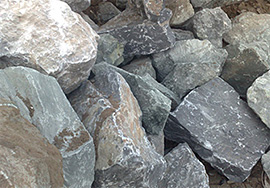
Le calcaire est la roche sédimentaire de calcium formé sur le fond du lac dans lequel les matériaux riches en calcium s’entassent comme les coquilles et les squelettes. Le calcaire, qui se compose de calcite (CaCO3), est le fossile venant de matière organique dans le lac ou l’océan. Depuis des milliers et des millions d’années, les couches augmentent le poids. La chaleur et la pression provoque la réaction chimique au fond et les sédiments deviennent le calcaire solide. La roche contenant plus de 95% de carbonate de calcium est appelé le calcaire de calcium élevé. Avec le bon polissage, le calcaire recristallisé est généralement utilisé comme la pierre de décoration et construction.

Stage1: broken
The kaolin bulk material is crushed into a fineness of the mill (15mm-50mm) by crusher.
Stage2: milling
Crushed kaolin small pieces of material by the hoist to the silo, and then by the vibration feeder to its uniform quantitative into the mill grinding room for grinding.
Fine powder processing generally used LM vertical grinding, MTW European version of the mill, TGM overpressure trapezium milling machine; ultrafine powder processing generally use LUM ultra-fine vertical grinding, HGM ring roller micro-grinding machine.
Stage3: classification
After grinding the material by the separator for grading, unqualified powder was classified after the separator to return to the host to re-grinding.
Stage4: set powder
Fineness of the powder with the air flow through the pipeline into the dust collector for separation and collection, the collection of finished powder from the discharge port by the conveyor to the finished silo, and then unified with a loaded tanker or automatic baler for packaging.

Matière à traiter: Limestone
Granulométries finals: 0-6mm, 5-14mm, 14-25mm
Taille d’alimentation : 500 mm
Capacité de production: 100-120TPH

Matière à traiter: Limestone
Granulométries finals: 0-10mm, 10-20mm, 20-40mm
Taille d’alimentation : 820 mm
Capacité de production: 300 t/h